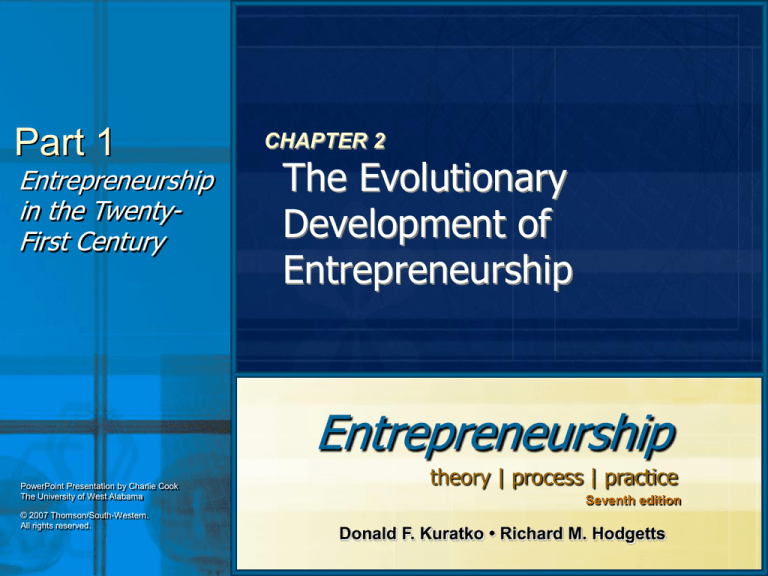
Part 1
Entrepreneurship
in the TwentyFirst Century
CHAPTER 2
The Evolutionary
Development of
Entrepreneurship
Entrepreneurship
PowerPoint Presentation by Charlie Cook
The University of West Alabama
© 2007 Thomson/South-Western.
All rights reserved.
theory | process | practice
Seventh edition
Donald F. Kuratko • Richard M. Hodgetts
Chapter Objectives
Studying this chapter should provide you with the
entrepreneurial knowledge needed:
1. To examine the historical development of
entrepreneurship
2. To explore and debunk the myths of entrepreneurship
3. To define and explore the major schools of
entrepreneurial thought
4. To explain the process approaches to the study of
entrepreneurship
5. To set forth a comprehensive definition of
entrepreneurship
© 2007 Thomson/South-Western. All rights reserved.
2–2
The Evolution of Entrepreneurship
Entrepreneur is derived from the French
entreprendre, meaning “to undertake.”
The entrepreneur is one who undertakes to organize,
manage, and assume the risks of a business.
Although no single definition of entrepreneur
exists and no one profile can represent today’s
entrepreneur, research is providing an
increasingly sharper focus on the subject.
© 2007 Thomson/South-Western. All rights reserved.
2–3
A Summary Description
of Entrepreneurship
Entrepreneurship (Robert C. Ronstadt)
The dynamic process of creating incremental wealth.
This wealth is created by individuals who assume
major risks in terms of equity, time, and/or career
commitment of providing value for a product or
service.
The product or service itself may or may not be new or
unique but the entrepreneur must somehow infuse
value by securing and allocating the necessary skills
and resources.
© 2007 Thomson/South-Western. All rights reserved.
2–4
An Integrated Definition
Entrepreneurship
A dynamic process of vision, change, and creation.
• Requires an application of energy and passion towards the
creation and implementation of new ideas and creative
solutions.
Essential ingredients include:
• The willingness to take calculated risks—in terms of time,
equity, or career.
• The ability to formulate an effective venture team; the creative
skill to marshal needed resources.
• The fundamental skills of building a solid business plan.
• The vision to recognize opportunity where others see chaos,
contradiction, and confusion.
© 2007 Thomson/South-Western. All rights reserved.
2–5
The Myths of Entrepreneurship
Myth 1: Entrepreneurs Are Doers, Not Thinkers
Myth 2: Entrepreneurs Are Born, Not Made
Myth 3: Entrepreneurs Are Always Inventors
Myth 4: Entrepreneurs Are Academic and Social Misfits
Myth 5: Entrepreneurs Must Fit the “Profile”
Myth 6: All Entrepreneurs Need Is Money
Myth 7: All Entrepreneurs Need Is Luck
Myth 8: Ignorance Is Bliss For Entrepreneurs
Myth 9: Entrepreneurs Seek Success But Experience High Failure
Rates
Myth 10: Entrepreneurs Are Extreme Risk Takers (Gamblers)
© 2007 Thomson/South-Western. All rights reserved.
2–6
Figure 2.1 Entrepreneurial Schools-of-Thought Approach
© 2007 Thomson/South-Western. All rights reserved.
2–7
Macro View: External Locus of Control
The Environmental School of Thought
Considers the external factors that affect a potential
entrepreneur’s lifestyle.
The Financial/Capital School of Thought
Based on the capital-seeking process—the search for
seed and growth capital.
The Displacement School of Thought
Alienation drives entrepreneurial pursuits
• Political displacement (laws, policies, and regulations)
• Cultural displacement (preclusion of social groups)
• Economic displacement (economic variations)
© 2007 Thomson/South-Western. All rights reserved.
2–8
Table 2.1
Financial Analysis Emphasis
© 2007 Thomson/South-Western. All rights reserved.
2–9
Micro View: Internal Locus of Control
The Entrepreneurial Trait School of Thought
Focuses on identifying traits common to successful
entrepreneurs.
• Achievement, creativity, determination, and technical
knowledge
The Venture Opportunity School of Thought
Focuses on the opportunity aspect of venture
development—the search for idea sources, the
development of concepts, and the implementation of
venture opportunities.
• Corridor principle: New pathways or opportunities will arise
that lead entrepreneurs in different directions.
© 2007 Thomson/South-Western. All rights reserved.
2–10
Table 2.2 Definitions And Criteria Of One Approach To The Micro View
Source: Adapted from J. Barton Cunningham and Joe Lischeron, “Defining Entrepreneurship,” Journal of
Small Business Management (January 1991): 56.59(1) (winter 1994): 21-31. Reprinted with permission.
© 2007 Thomson/South-Western. All rights reserved.
2–11
Table 2.2 Definitions And Criteria Of One Approach To The Micro View
(cont’d)
Source: Adapted from J. Barton Cunningham and Joe Lischeron, “Defining Entrepreneurship,” Journal of
Small Business Management (January 1991): 56.59(1) (winter 1994): 21-31. Reprinted with permission.
© 2007 Thomson/South-Western. All rights reserved.
2–12
Table 2.2 Definitions And Criteria Of One Approach To The Micro View
(cont’d)
Source: Adapted from J. Barton Cunningham and Joe Lischeron, “Defining Entrepreneurship,” Journal of
Small Business Management (January 1991): 56.59(1) (winter 1994): 21-31. Reprinted with permission.
© 2007 Thomson/South-Western. All rights reserved.
2–13
Micro View… (cont’d)
The Strategic Formulation School of Thought
Emphasizes the planning process in successful
venture development.
Ronstadt’s View
Strategic formulation is a leveraging of unique
elements:
•
•
•
•
Unique Markets: mountain gap strategies
Unique People: great chef strategies
Unique Products: better widget strategies
Unique Resources: water well strategies
© 2007 Thomson/South-Western. All rights reserved.
2–14
Process Approaches to Entrepreneurship
Integrative Approach
Built around the concepts of input to the
entrepreneurial process and outcomes from the
entrepreneurial process.
Focuses on the entrepreneurial process itself and
identifies five key elements that contribute to the
process.
Provides a comprehensive picture regarding the
nature of entrepreneurship that can be applied at
different levels.
© 2007 Thomson/South-Western. All rights reserved.
2–15
Figure 2.2 An Integrative Model of Entrepreneurial Inputs
and Outcomes
Source: Michael H. Morris, P. Lewis, and Donald L. Sexton, “Reconceptualizing Entrepreneurship:
An Input-Output Perspective,” SAM Advanced Management Journal 59(1) (winter 1994): 21–31.
© 2007 Thomson/South-Western. All rights reserved.
2–16
Process Approaches… (cont’d)
Entrepreneurial Assessment Approach
Stresses making assessments qualitatively,
quantitatively, strategically, and ethically in regard to
the entrepreneur, the venture, and the environment
Multidimensional Approach
Views entrepreneurship as a complex,
multidimensional framework that emphasizes the
individual, the environment, the organization, and the
venture process.
© 2007 Thomson/South-Western. All rights reserved.
2–17
Figure 2.3 Entrepreneurial Assessment Approach
Source: Robert C. Ronstadt, Entrepreneurship (Dover, MA: Lord Publishing Co., 1984), 39.
© 2007 Thomson/South-Western. All rights reserved.
2–18
Figure 2.4
Variables in
New-Venture
Creation
Source: William B. Gartner, “A Conceptual Framework for
Describing the Phenomenon of New Venture Creation,”
Academy of Management Review (October 1985): 702.
Reprinted with permission.
© 2007 Thomson/South-Western. All rights reserved.
2–19
Intrapreneurship
(Corporate Entrepreneurship)
Intrapreneurship
Entrepreneurship that takes place within an
organization
Intrapreneuring (corporate entrepreneurship)
To create or develop the entrepreneurial spirit within
corporate boundaries, thereby allowing an
atmosphere of innovation to prosper.
© 2007 Thomson/South-Western. All rights reserved.
2–20
Key Concepts
Entrepreneurship
A process of innovation and new-venture creation
through four major dimensions—individual,
organizational, environmental, process—that is aided
by collaborative networks in government, education,
and institutions.
Entrepreneur
A catalyst for economic change who uses purposeful
searching, careful planning, and sound judgment
when carrying out the entrepreneurial process.
© 2007 Thomson/South-Western. All rights reserved.
2–21
Key Concepts
Entrepreneurial Management
The discipline of entrepreneurial management:
• Entrepreneurship is based upon the same principles.
• It matters not who or what that the entrepreneur is—an
existing large institution or an individual, for-profit business or
a public-service organization, a governmental or nongovernmental institution.
• The rules are much the same: things that work and those that
don’t are much the same, and so are innovations and where
to look for them.
© 2007 Thomson/South-Western. All rights reserved.
2–22
Key Terms and Concepts
better widget strategies
corridor principle
displacement school of thought
entrepreneur
entrepreneurial assessment
approach
entrepreneurial management
entrepreneurial trait school of
thought
entrepreneurship
environmental school of thought
external locus of control
financial/capital school of
thought
© 2007 Thomson/South-Western. All rights reserved.
great chef strategies
internal locus of control
intrapreneurship
macro view of entrepreneurship
micro view of entrepreneurship
mountain gap strategies
multidimensional approach
strategic formulation school of
thought
venture opportunity school of
thought
water well strategies
2–23








